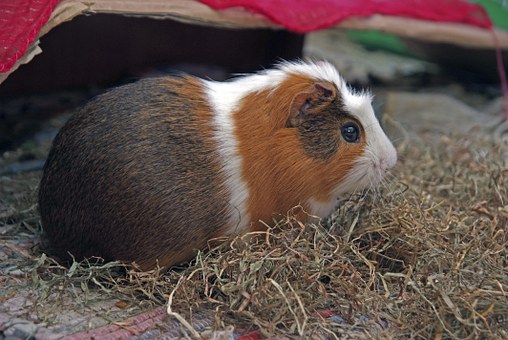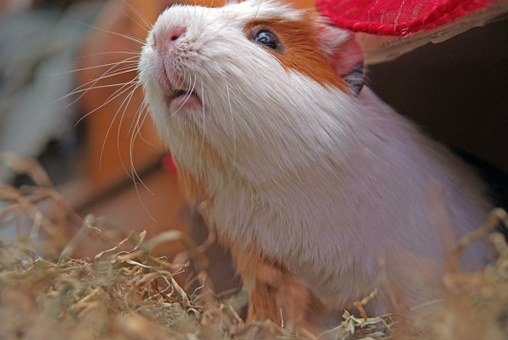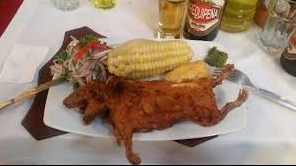Dude, You're eating my Pet!
Eating Typical Foods in Ecuador
“What are those?” a recent visitor studying Spanish in Ecuador asked. “They’re so cute.” Passing through a region of small farms near Quito, we’d stopped to a short break when she spotted the animals running around the front yard of a nearby farmhouse. “Oh, it’s a Cuy” the farmer’s wife responded in accented Spanish picking up one of the little brown and white furred whistlers to show the visitor. “Why do you have so many little pets?” the conversation continued. “They’re not pets Dear”, the woman continued, “We sell them to eat.”

“You mean you EAT them!” the visitor almost screamed nearly dropping the little critter still cradled in her hands. Yes, here in Ecuador people eat Cuy. It’s one of the typical foods here in the Andes.
What is Cuy?
The Cuy, also known as Guinea Pig, “Cobayo”, “Conejo de Indies” or “cavy” (Cavia Porcellus) is a small, furry rodent-family animal typically raised as a staple food in Ecuador, Peru, Bolivia and Colombia. It is similar in size to a rabbit and is a herbivore in addition to being similar in habits and temperament to rabbits. Often commercial farms which raise Cuy also raise rabbits. Cuy as they exist today no longer appear naturally in the wild but are strictly raised by families or on farms. Other names for Cuy are “Quwi” or “Jaca” in the Quechua Indian language.
How is Cuy prepared?
In Ecuador, the preparation usually is by scraping the hair off the skin then roasting the cleaned, split animal whole on a spit or skewer. The roasted, or sometimes fried whole Cuy, is served with rice, potatoes and a salad of cucumbers, lettuce, tomatoes, and onions. In Colombia they are most often whole roasted and served with freshly popped popcorn with the liver, heart boiled and prepared as garnish. In Peru, a spicy sauce of peppers and achiote accompanies the whole roasted Cuy. They can also be baked or barbecued. Chica (corn beer) or Morada (a sweet, spicy, purple corn drink) are often served with cuy.

Where is it eaten?
In Indigenous communities in Ecuador, Bolivia and Peru, the cute, furry guinea pigs are frequently given in mating pairs as gifts to recently married couples who will breed and raise them in a backyard, on the flat roof of their house or in clean wire caged pens. Occasionally, a concrete-walled pen is constructed in a sheltered area of a small farm to raise Cuyes (plural of Cuy). Farms in Argentina and Bolivia, as in Colombia, Ecuador and Peru likewise raise them as a typical, staple food source. More recently, cuy are exported to the U.S. and is available in supermarkets serving Latino neighborhoods in cities like New York.
Who ate it in the past?
Cuy have been cultivated as a food staple since around 2000 B.C. Pre-Columbian Inca Royal Families traditionally prepared them as food. Cuy were also used in ritual sacrifices and their entrails were used to foretell the future. The animal is featured in the Inca culture history in the South American Andes regions. Spanish conquistadors, Dutch and English explorers brought the creatures to Europe. Europeans however, regarded them more as a kind of exotic pet. The Cuy is mentioned in writings dating from 1547. Later, they began to be used as animals for scientific or medical experimentation. This practice has now been greatly diminished during the twenty-first century with Guinea Pigs being replaced by mice, although in North American culture, Guinea Pigs or Hamsters, a related species, can still be purchased as pets.
Where do I go to try eating Cuy?
Cuy can be purchased cleaned and skinned at a number of Indigenous markets in the Andean regions of Ecuador and much of Peru. Cooked Cuy are available in many restaurants featuring typical Andean dishes, local farms and roadside stands specializing in cuyes and rabbits ranging from Colombia, Ecuador and Peru to Argentina.

Can eating Cuy make me sick?
Since Cuyes are almost always raised under very clean, hygienic conditions and are herbivores they virtually never present a health problem. The animal will get sick easily if not kept under the strictest conditions of cleanliness so are quickly disposed of on commercial farms. Having a flavor similar to farmed rabbit, they are thoroughly cooked by frying or roasting whole after a strenuous preparation and cleaning including removal of all fur and viscera. In any place where cuy are regularly and frequently prepared, there is little danger of getting sick from eating cuy in Ecuador. So relax and enjoy this typical food of the Andes.
Source: Larry Lynch
“If you liked this post, please follow me here on Steemit. I’ll follow you back. I’ll be bringing you more good quality content in the weeks to come.”